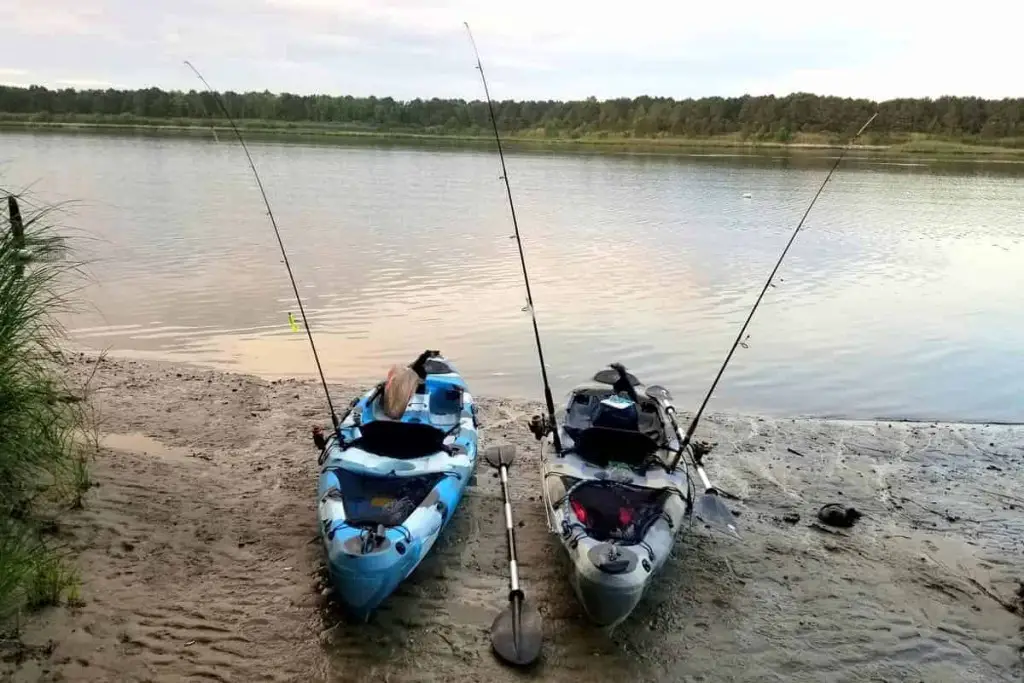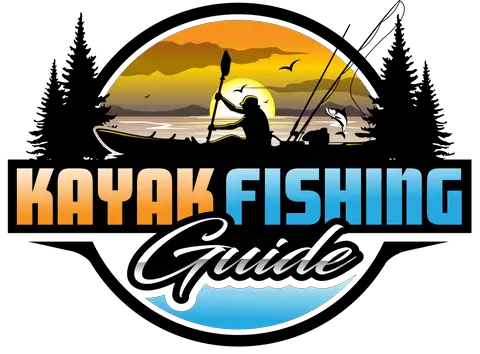As a custom fishing rod builder, I have built many fishing rods for myself and others over the years. There are countless variables involved in building a quality fishing rod, but the question most often asked of me is, “How long of a rod do I need?” My response is…
The best overall rod length for kayak fishing inland is 7 feet, while offshore rods are generally between 8 to 9 feet in length. You want a rod long enough to reach past the bow of your kayak, to keep you from tipping over and going into the water if a large fish goes underneath your kayak.
The type of fishing and fish species will dictate the best specific rod length. Shorter, heavier rods are good for closer, thicker cover; longer, lighter rods cast further.
If you’re in a hurry and looking for a quality kayak rod, check out the St Croix Mojo Yak Spinning Fishing Rod, or if you’re looking for a baitcaster, the St Croix Mojo Bass Casting Rods. Both can be found on Amazon.
In my opinion, both are high-quality, well-built rods. I have built quite a few fishing rods on the St. Croix fishing blanks, which are excellent sticks!
What You Should Consider in a Kayak Fishing Rod

Several factors should be considered when choosing a fishing rod length for your kayak. Let’s take a quick moment to review them below.
Best Overall Kayak Rod length
As fishing rods become longer, they don’t necessarily mean they are better for kayak fishing! Longer rods become more cumbersome to handle in a kayak.
Longer length rods equate to a longer casting distance, though. Shorter rods are easier to move around, cast, and store in your kayak. So, where’s the length of diminishing returns?
For freshwater kayaking on lakes, rivers, and ponds, the best overall length for a kayak is at the seven-foot mark.
If you’re fishing offshore, the recommended length is between eight to nine feet.
1. Your Rod Tip Should Reach the End of the Kayak
One of the dangers of kayak fishing is the threat of being pulled over into the water. You need to adjust your rod tip quickly when a fish runs beneath your kayak from one side to the other.
The best way to fight a fish is with your rod tip pointing to the front of the kayak. In this manner, you’ll have leverage on the fish. Your kayak is more stable from bow to stern than it is from side to side!
Once a fish swims beneath your kayak and to the other side, all the leverage is with the fish. This pulling action can cause a kayak to tip over to the side, as shown in the Robert Field, YakGear.com Ambassador video below.
To keep this from happening, it is good practice to fish with a rod long enough to reach past the bow of your kayak. As the fish swims beneath your kayak, you swing the rod tip around the front of the bow and to the other side.
Keep in mind that you really want to position the kayak so you are following the fish. Whenever possible, fight the fish from the front of your yak and not from the side.
2. Use a Shorter Butt Length
A shorter butt length, the distance between the reel and the bottom (butt end) of the rod handle, doesn’t get caught up in your PFD, shirt, or jacket like a longer split grip or rod handle will.
Many of the custom rods I build are designed to the user’s specifications, and butt lengths will vary depending on their needs or fishing styles.
However, space is at a premium for kayak fishing because you are typically sitting in a confined space on your kayak. When wearing your life jacket or PFD, shirt, jacket, or waterproof suit, the end of the rod tends to become hung up on your clothing and safety gear.
A shorter butt length will keep this from happening! So, choose a rod with a smaller length handle when you’re concerned about getting caught up in your clothing!
3. Longer Rods Equal Longer Casting Distances
A longer fishing rod has more hook-setting leverage and will cast further. This can be important if you’re fishing for a species like a redfish or a tarpon, which may spook if you come too close.
One caveat of the longer rod is you’ll give up a certain amount of accuracy in your casting. As a rod becomes longer in length and you cast further, wind and other variables can come into play to move your lure or bait off target.
Longer rods cover greater amounts of water when casting. When crankbaits are used, the baits tend to dive a little bit deeper as well.
With a longer rod, you also gain the hook-setting advantage! A longer rod develops more leverage, and you have a longer “sweep” of the rod to bury that hook set home!
If you’re creek or river fishing or spend much time around brush and covered shorelines, you might find the longer rods to hang up quite often.
4. Shorter Rods Equal Accurate Casting
Shorter fishing rods will give you far better casting accuracy than their longer counterparts.
When you’re fishing in backwater spots like small creeks, canals, or even sloughs, there will be quite a bit of overhanging brush and vegetation. A shorter rod length will allow you to maneuver in these areas easily.
Casting topwater frogs or plugs into small, tiny openings and lighter baits to match the forage in these waters is much easier with a shorter rod!
You’ll also find that the shorter rods are easier to handle if you’re fishing around boat docks, ropes, and cables. A popular fishing technique is to “skip” baits back beneath docks to fish protected in the shadows of the dock.
Shorter rods excel in these areas!
5. Consider Two-Piece Rods for Traveling
Whichever length rod fits your situation better, one consideration to remember when traveling with your rods is possible damage to them!
A longer rod tends to be damaged more often than a shorter rod. I’ve shut them in car and truck doors and snapped the top section off! I’ve even broken a few rods when they became caught in a truck’s tailgate!
When traveling with fishing rods, I found that two-piece rods were easier to pack and fit better behind the truck seat or strapped into the kayak.
It’s been my experience with today’s high-tech rods; you will lose virtually no feeling due to dampening in a two-piece rod over a single rod.
Many years ago, the ferrules (the joint where the rod pieces connected) were made from metal, making the rod quite stiff and cumbersome. Today, a variety of high-tech materials are used in rods. Two-piece rods are highly sensitive, and you can still feel the lightest bites!
Final Thoughts
Overall, a good-quality 7′ rod will be more than adequate for most freshwater fishing from a kayak. If you’re fishing saltwater or need to cast long distances, use the longer rod if it suits your fishing style.
If you travel any distances and are concerned about your rods arriving safely and intact, you may want to consider a two-piece rod. They travel and pack much more easily!
A couple of additional articles you may want to check out are:
- Piscifun Fishing Reels: Are They Any Good? (The Facts!)
- Can You Add Rod Holders to Your Kayak?
- Can You Fish From a Regular Kayak?
Have fun, and stay safe out there!
